Reality Trek
Tech from Star Trek that's here today...or on the way!By Ed Oswald | Wednesday, April 8, 2009 at 11:48 pm
 In just a month from now, I and millions of other Trekkies will have our behinds firmly planted in movie theater seats, taking in the latest Star Trek film, directed by Lost’s J.J. Abrams. I can not tell you how excited I am. Just as with Battlestar Galactica, a re-imagining of the series is much needed to make the old show relevant to today’s more demanding audience. The Trek films of the past became campy relics of a bygone period in sci-fi. But for all its period feel, Star Trek is also oddly contemporary. Over the franchise’s four-decade history, the TV series and movies have influenced–or at least predicted–multiple new technologies and gadgets that are either now available or on the way.
In just a month from now, I and millions of other Trekkies will have our behinds firmly planted in movie theater seats, taking in the latest Star Trek film, directed by Lost’s J.J. Abrams. I can not tell you how excited I am. Just as with Battlestar Galactica, a re-imagining of the series is much needed to make the old show relevant to today’s more demanding audience. The Trek films of the past became campy relics of a bygone period in sci-fi. But for all its period feel, Star Trek is also oddly contemporary. Over the franchise’s four-decade history, the TV series and movies have influenced–or at least predicted–multiple new technologies and gadgets that are either now available or on the way.
So in anticipatory celebration of the eleventh Trek movie, here’s a look at eleven current and emerging technologies that were foreshadowed by the tech of Trek.
Live long and prosper.
11. Tractor beams
When the Enterprise needed to grab hold and tow something, Captain Kirk called for the tractor beam. It was like a virtual rope, grabbing onto an item and pulling it along. Researchers at MIT have indeed begun work on such an item, using light to pick up, move and place cells on the surface of a microchip.
Below, is a example of their work, where they used E-coli cells to spell out “MIT.”

It may not be powerful enough to lug an entire starship, but it’s a start.
10. Transporters
“Beam me up, Scotty!” is one of the most recognizable phrases in television history. While transporting people still appears to be a long way off, scientists have begun work on teleportation systems. One of the first reported successes was in 2004, when researchers from the University of Innsbruck and the National Institute of Standards and Technology independently claimed breakthroughs.
The groups were able to teleport an atom from one location to another without any physical connection. But this was at the quantum level, meaning it was more a transfer of information than actual matter. While scientists disagree on whether transportation a la Star Trek is possible, it hasn’t been completely ruled out.
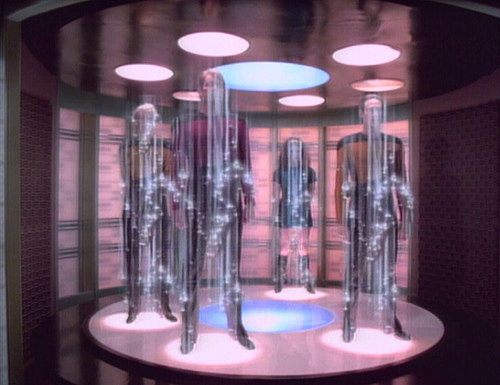
9. Biometrics
While biometrics weren’t a unique Star Trek trademark, face and voice recognition, retinal scans, and palm readers all saw use in the series and movies. And now the idea has made it into our everyday lives. Instead of an easily forged signature or other means of identification, verifying identities through physical characteristics is becoming increasingly common. In an age of increasing identity theft, that might not be such a bad thing.

8. Tricorders
The away teams sent to the surface of a new planet always carried along the trusty tricorder, a handheld scanning unit that provided all kinds of information about the surroundings. Today, most of us carry around our own handheld devices that help us explore the world around us.
Even more tricorder-like technologies are in development as we speak. In 2007, Purdue University researchers developed a handheld device that scans the chemical makeup of samples. Another invention by University of Washington doctors allows doctors to focus a ultrasound beam at an area to promote healing. While this is most reminiscent of Beverly Crusher’s use of tricorders to repair broken bones and the like, it still sounds an awful lot like what was used on Star Trek.
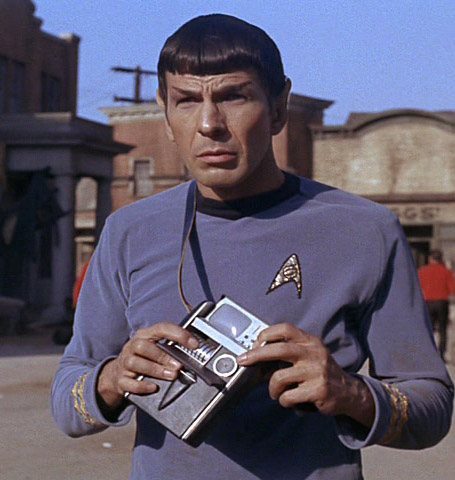
7. Cloaking
Those pesky Romulans always seemed to materialize out of thin air, thanks to their cloaking technology. Researchers are using some of the same principles, making something appear invisible when it is actually there, in efforts to protect army troops.
The first real-world example is a a technology that projects the surrounding landscape onto an object to make it appear as if it was not there. British Army researchers plan to have such a system ready for use on tanks by 2012.

6. Phasers
These laser-beam shooting rifles were the crew’s weapon of choice, capable of both stunning and killing an enemy, and on their highest settings able to completely vaporize an object. Star Trek wasn’t the only sci-fi show to make use of laser-based weapons, but in any case, laser weapons are just around the corner. In tests earlier this year, Northrop Grumman announced that it had been successful in producing a 105 kilowatt laser beam, pass the 100 kilowatts considered to make a laser “weapons grade.”
While the company says 25-50KW should be good enough for most “military applications,” this 105KW laser far exceeds that. It won’t be able to do a ton of damage, but it’s the first real major step in bringing laser weapons to the battlefield.

5. Hyposprays
Hate needles? In 22nd and 23rd century society, you don’t have much to worry about. That’s because doctors use something called a hypospray, which injects medication into the body without having to prick the patient.
Several companies and researchers are working on such devices. National Geographic reported on one of these inventors last year, Japan’s Yoshoi Oyama. His “Mother’s Kiss” device uses gases and pressure to deliver the injection without a needle.
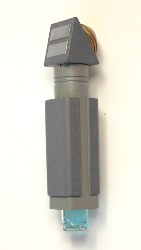
4. Telepresence
Communicating via voice alone is so…20th century. In the Star Trek realm, the Starfleet (and its enemies) talk to each other via video. When the first series came out in the 1960s, videoconferencing was something you were unlikely to see anywhere other than the World’s Fair.
These days, tvideoconferencing is commonplace and in use by many businesses worldwide. Now, companies like Cisco are pushing that even further with TelePresence, a high quality, large-screen videoconferencing technology.
Video technologies are also making it into cellular communications as well. Japanese carriers are beginning to offer videoconferencing-capable phones, and it’s only a matter of time until the technology makes it to the U.S.
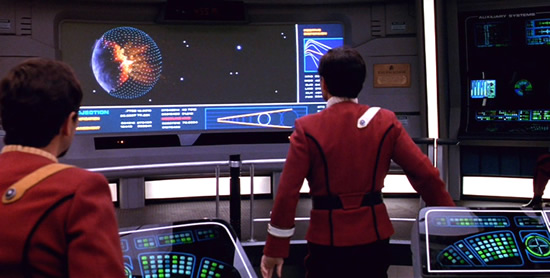
3. The Sickbay
This wasn’t Star Trek’s most high-tech innovatiom, but its use on the original show directly influenced that of the US Navy. The Navy found the set up of the “bio-bed” useful, with the patient’s vital statistics displayed above the bed. Thus in more modern ships, the sickbays look somewhat like the one that Doctor McCoy presided over.
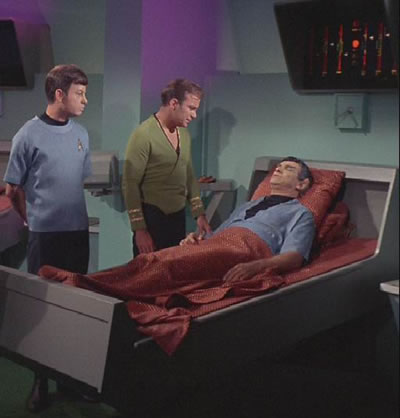
2. Deflector Shields
The deflector shield was one of the protective measures of the Enterprise that was less intended for defense than protecting the crew. As the more space-aware among us know, outer space is filled with harmful radiation that can be dangerous to humans. The deflector shield protected the crew by keeping this radiation at bay.
Well, Star Trek was not too far off from reality. Researchers last year found that creating a portable magnetic field around a space-faring vessel could protect the crew during long voyages. This field would curve these particles around the ship much like the deflector shield did on the Enterprise.
While originally it was thought that a large-scale field was needed to protect humans from these rays, it has now been discovered that small-scale fields work equally well.
This could be a important invention as it appears this century our civilization is set to venture off our planet a whole lot more often to see the cosmos up close and personal.
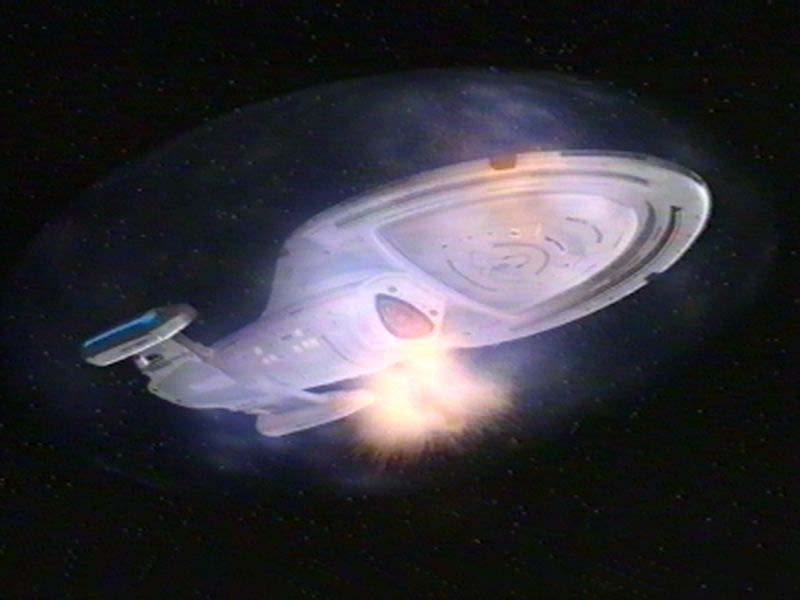
1. Warp Drive
I saved the best for last. Previous sci-fi shows touched on the idea of faster-than-light travel, but Star Trek made it a bigger part of the idea of space travel. While we are certainly nowhere near being able to travel at the speed of light, the series got scientists talking to determine if it even would be possible. At least two groups of scientists have recently argued that warp speed is indeed a possibility.
Both argue (see here and here) that traveling faster than the speed of light requires that the fabric of space be manipulated. Its a long way off, so we won’t be warping off anytime soon–maybe not even in 2053, which is the date that Star Trek gives for the invention of the warp drive.
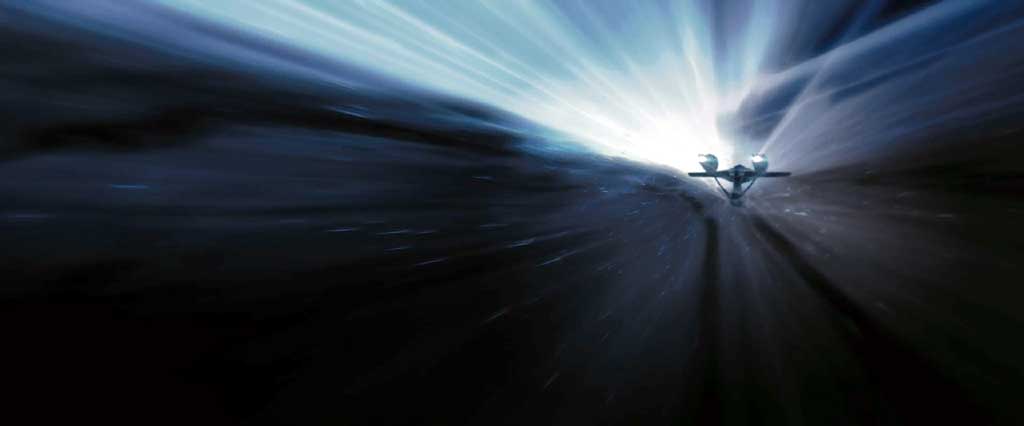
(Star Trek images copyright (c) CBS Studios.)
13 Comments
Read more:













April 9th, 2009 at 3:16 am
It’s a cool article. We don’t usually think about the wonders we have available to us nowadays. The impact is so much bigger when you do this kind of comparison with SciFi. But you are really stretching it on the Warp drive. Scientists saying it could be possible is a long way from it being “on the way”.
April 9th, 2009 at 7:59 am
Yea– don’t hold your breath on Warp Drive.
The thing I liked best about Star Trek: the plots. They took on racism, intolerance, nuclear proliferation– all kinds of very modern issues– in the early 1960’s, in the middle of the Viet Nam war, in a time when lynchings were still common. Lesser franchises, like Star Wars, are a lot lighter on social issues, IMHO, “The Force” notwithstanding.
April 9th, 2009 at 8:06 am
neat story ed!
April 9th, 2009 at 8:08 am
@tom b In the Star Wars comics the Sith were prejudiced against any non-human species, but the movie was just glib fun. Roddenberry rocked for really using his show to appeal to higher ideals.
April 9th, 2009 at 8:49 am
Star Trek, however did spur a lot more talk on faster than light travel, or at least ways for high speed spaceships. Look at ion propulsion.. that is the next movement in space travel… and is very simular to the “impulse” drives used on Star Trek.
Speed right now is space travel’s biggest problem — and hurdle as well.
April 9th, 2009 at 10:46 am
I received an innoculation from an air-based injector back in the sixties.
If you convert enough energy to mass, would you ‘bend’ space/time?
April 9th, 2009 at 11:02 am
the cool tech gadgets no doubt played a part in the success of the series both TV and film, but the bonding and synergy of races encompassing an entire planet on the Enterprise is what makes a mere TV show a watershed event in Human History. the show, more than anything else, illustrated that everyone has something to contribute and should be proud and accepting of who they are no matter the degree of their apparent differences.
we may never be able to bend the fabric of time, but Star Trek did and continues to bend the Fabric of Human Intercourse in a way that we can only hope is a part of Mankind’s future.
April 9th, 2009 at 11:04 am
**edit**
and besides, the alien crash at Roswell is chiefly responsible for the technology we have today
April 9th, 2009 at 3:38 pm
2063, not 2053.
Also, don’t give up hope: a lot can happen in 55 years.
Consider, in 1895, cars and airplanes essentially did not exist (let alone space craft); computers weren’t even a figment of the imagination; power was limited to mostly coal plants (or worse) etc.
55-years later, and you’re at 1950: cars are everywhere, jet travel is starting to become mainstream; the V-2 rocket has helped pave the way for the 1st satellite launch (to occur in less than 10 years); the power of the atom has been harnessed; the earliest computers (mainframes with punch cards) are coming online, etc.
55-years is a LONG time.
April 9th, 2009 at 3:41 pm
@tom b
There’s no doubt whatsoever that Star Trek was made for grown up people who like to have their neurons stimulated, while Star Wars is more directed at people who like heroes and exploding spaceships. There’s a place in my hear for both of them.
October 4th, 2009 at 6:48 am
It’s good to hear the my childhood favorite show foretold all the technological wonders that are now mostly common in our daily lives. It only goes to prove right that “what man can conceive man can achieve.”
November 28th, 2009 at 3:35 pm
It’s tough to find Roswell episodes but after searching I founf them at http://www.roswellonline.blogspot.com they dont have every episode but that’s ok there’s enough for me to get my fix.
October 31st, 2010 at 12:21 pm
This weblog appears to get a good ammount of visitors. How do you advertise it? It gives a nice unique spin on things. I guess having something real or substantial to talk about is the most important thing.